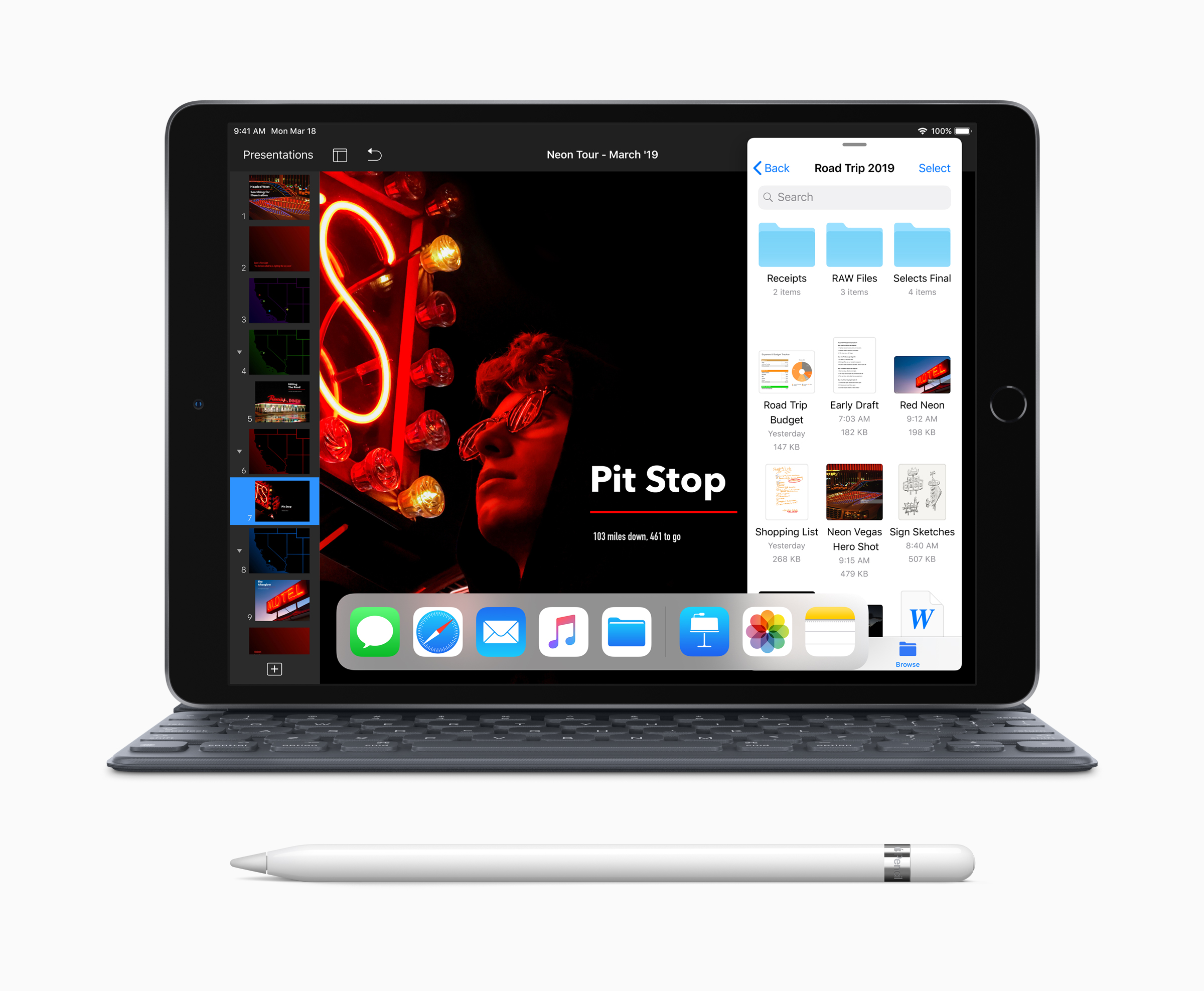- Apple’s new iPad Air fills a void that was missing in Apple’s lineup.
- It’s for for those who want better performance than the budget iPad, but don’t want to splurge on the Pro.
- It shines as a general-purpose tablet suitable for entertainment and light work.
- However, there are other attractive options worth considering for those who are willing to use Android or Windows.
When it comes to the iPad, Apple’s focus seems to have been fixated on its Pro line and the 9.7-inch iPad in recent years. For example, it launched a revamped pair of iPads last October that bring Face ID and a nearly all-screen design to Apple’s high-end tablets. Before that, it updated the low-priced $329 iPad, giving it with a 9.7-inch screen that works with the Apple Pencil.
But until this month, it had been several years since we’ve heard anything about the iPad Air. Apple quietly changed that when it launched an updated model on March 18 that runs on the same A12 Bionic processor that powers its latest iPhones. The new tablet, which starts at $499, also supports the first-generation $99 Apple Pencil and Apple’s $159 Smart Keyboard. It also features an improved screen.
The new Air represents a much-needed addition to Apple’s tablet lineup, serving as a viable option for those who don’t need the power of the iPad Pro, but who still want a higher-quality screen and more storage space than what’s available in the $329 model. However, there are other similarly priced tablets not made by Apple that fill that same void, which could be worth considering for those willing to try Android or Windows.
Here’s a closer look at what it’s been like to use the new iPad Air.
Design and screen

The new iPad Air looks very similar to the 10.5-inch iPad Pro, first launched by Apple in 2017. Like that tablet, the iPad Air's screen is framed by bezels that are fairly slim along the sides and thicker around the top and bottom where the iPad's front camera and Touch ID home button are located. It's not a distinct redesign like what we've seen on Apple's 2018 iPad Pro, which sports a nearly borderless edge-to-edge screen and Face ID just like Apple's iPhone X lineup.
The newest iPad Pro certainly has a more forward-looking aesthetic that indicates where Apple's design ambitions are heading, but the refreshed Air is an attractive tablet nonetheless with a design that matches its price. I much prefer the new iPad Air's look to that of the new iPad mini, which has noticeably chunkier bezels that make the design feel a bit dated.
Apple's latest iPad has a 10.5-inch screen with a resolution of 2224 by 1668 with 264 pixels per inch - just like the older 2017 10.5-inch iPad Pro that Apple no longer sells. Like Apple's modern iPhones and iPads, the new Air also has a wide color display and the company's TrueTone technology baked into its screen, which adjusts the screen's white balance based on your environment. In my experience, TrueTone usually makes reading and web browsing on the iPad more comfortable since it eliminates the blueish tint that comes from the screen's light, which can be particularly noticeable on websites with white backgrounds.
Other than its size, one of the main differences between the screen on the new iPad Air and that of the recently launched iPad Pros is that the Air lacks Apple's ProMotion technology, which is designed to make tasks like scrolling feel more smooth thanks to its increased refresh rate. This doesn't hamper the experience in everyday use, however, especially if you intend to use the iPad primarily for entertainment.
The iPad Air's display is certainly sharp and colorful enough to make for an excellent entertainment device. But I'm itching to see an iPad with an OLED screen - although if Apple were to outfit any of its tablets with that type of display technology it will likely show up on its pricier Pro models first. OLED is the type of screen technology Apple uses on its high-end iPhones, starting with the iPhone X and continuing with the iPhone Xs and iPhone Xs Max. It's typically more expensive than the LCD panels Apple uses for its other devices and usually offers better contrast.
Performance and battery life

The A12 Bionic chip is plenty powerful for many of the tasks for which you'd want to use an iPad. Playing mobile games like Real Racing 3, watching Netflix, managing email, and working in Google Drive were all a breeze on the iPad Air. I was even able to export short 4K video clips in iMovie without any noticeable lag.
And more importantly, it has sufficient enough battery life to handle those tasks without keeping you tied to the nearest power outlet. After roughly six hours of use, which included a mix of watching video, web browsing, note taking in Google Drive, and leaving the iPad idle with the screen turned on while I went about other tasks, Apple's tablet still had 40% of its power remaining. It's worth noting that battery life varies depending on how you're using the tablet, and not everyone will get the same results. Using certain apps and games, for example, will drain the battery faster.
For me, the iPad's large screen and portable size make it first and foremost an entertainment device. But even though it's not meant to be a powerhouse like its pricier Pro sibling, the Air also works well as a general use computer. It's ideal for those in-between tasks that aren't worth booting up your computer for but are too cumbersome to type out on a smartphone keyboard - taking notes in a meeting, answering long emails, and jotting down ideas all fall into this category for me.
While the iPad is better positioned than ever before to serve as a work device, thanks to new software features and the App Store's wide selection of productivity apps, I still wouldn't want to use it as my primary work device. That's because the iPad's software still isn't as well-suited for multitasking as desktop software like macOS or Windows 10, even despite the fact that Apple has brought features like split screen mode and picture-in-picture to its tablet lineup in recent years.
Should you buy it?

Of all of the entire current iPad lineup, the new iPad Air seems poised to be the one that best fits the needs of most people. The iPad Air's starting price of $499 seems fair for the quality of the experience, and if you're looking for an iPad with an expansive screen for watching movies, playing games, and doing light work, this is it.
But if you really just want a tablet for getting online, checking email, and playing casual games, it might be worth checking out the cheaper $329 iPad. The iPad Air is a better choice for those who anticipate needing the extra storage space and larger screen that Apple's new tablet provides, and who don't want to spend $800 on a Pro. (The Air comes with either 64GB or 256GB of storage while the regular iPad comes in 32GB and 128GB options). If you store a lot of photos and movies on your iPad versus in the cloud, and want a slightly larger screen for working or photo editing, the Air might be for you.
The iPad Air performs well general purpose tablet, but those who aren't married to Apple's ecosystem have other attractive options to consider. Samsung's Galaxy Tab S4, now priced at $549, is just $50 more expensive than the Air and includes Samsung's S Pen stylus at no additional cost. Plus, it has a higher-resolution AMOLED screen and four speakers instead of the iPad Air's two, which could make it an even more capable Netflix machine than the iPad. Those who want a cheap, portable tablet for work should also consider the $499 Microsoft Surface Go, which runs Windows 10 (in S-Mode, meaning it only runs apps from the Windows Store) and is compatible with Microsoft's $129.99 Signature Type Cover, which I usually prefer to Apple's more expensive Smart Keyboard.

